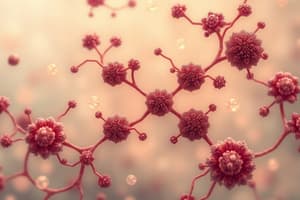Podcast
Questions and Answers
Which phase of pharmacokinetics describes how a drug spreads throughout the body’s tissues?
Which phase of pharmacokinetics describes how a drug spreads throughout the body’s tissues?
- Metabolism
- Excretion
- Absorption
- Distribution (correct)
What is a major mechanism involved in drug absorption that utilizes energy?
What is a major mechanism involved in drug absorption that utilizes energy?
- Passive diffusion
- Endocytosis
- Active transport (correct)
- Facilitated diffusion
In metabolic pathways, which enzymes are primarily responsible for phase I reactions?
In metabolic pathways, which enzymes are primarily responsible for phase I reactions?
- Transferases
- Hydrolases
- Cytochrome P450 (correct)
- Carboxylases
Which of the following is NOT a key parameter in bioavailability studies?
Which of the following is NOT a key parameter in bioavailability studies?
What type of study assesses the toxic effects of drugs using living organisms?
What type of study assesses the toxic effects of drugs using living organisms?
Which metabolic phase involves conjugation reactions such as glucuronidation?
Which metabolic phase involves conjugation reactions such as glucuronidation?
Which route of drug administration typically offers the highest bioavailability?
Which route of drug administration typically offers the highest bioavailability?
What type of toxicity is assessed by evaluating long-term drug effects on reproduction?
What type of toxicity is assessed by evaluating long-term drug effects on reproduction?
Flashcards are hidden until you start studying
Study Notes
dmpk Study Notes
Pharmacokinetics
- Definition: The study of how drugs move through the body over time.
- Key Phases:
- Absorption: How a drug enters the bloodstream.
- Distribution: How the drug spreads throughout the body’s tissues.
- Metabolism: The body's chemical alteration of the drug.
- Excretion: How the drug is eliminated from the body.
Drug Absorption
- Influencing Factors:
- Formulation: Solid vs. liquid forms; pH levels.
- Route of Administration: Oral, intravenous, intramuscular, etc.
- Physiological Factors: Blood flow, surface area of absorption, gastric emptying time.
- Mechanisms:
- Passive diffusion, facilitated diffusion, active transport, and endocytosis.
Metabolic Pathways
- Phase I Reactions:
- Oxidation, reduction, hydrolysis.
- Enzymes involved: Cytochrome P450 family.
- Phase II Reactions:
- Conjugation reactions (e.g., glucuronidation, sulfation).
- Involves transferases.
- Importance: Determines the drug's efficacy and toxicity.
Bioavailability Studies
- Definition: Measurement of the extent and rate at which the active ingredient or active moiety is absorbed and becomes available at the site of action.
- Methods:
- Absolute Bioavailability: Comparison with an intravenous dose.
- Relative Bioavailability: Comparison with another formulation.
- Key Parameters:
- Area under the curve (AUC), peak concentration (Cmax), time to peak concentration (Tmax).
Toxicity Evaluation
- Purpose: To assess the adverse effects of drugs on biological systems.
- Approaches:
- In vitro Studies: Cell line assays, enzyme inhibition studies.
- In vivo Studies: Animal models to evaluate systemic toxicity, organ-specific effects.
- Assessments:
- Acute toxicity, chronic toxicity, reproductive toxicity, carcinogenicity.
- Regulatory Considerations: Compliance with guidelines for preclinical and clinical testing.
Pharmacokinetics
- Studies drug movement in the body over time, crucial for understanding drug action and safety.
- Key phases include:
- Absorption: Entry of the drug into the bloodstream.
- Distribution: Dispersion of the drug across body tissues.
- Metabolism: Chemical transformation of the drug by the body.
- Excretion: Removal of the drug from the body.
Drug Absorption
- Influenced by various factors:
- Formulation: Different drug forms (solid vs. liquid) affect absorption; pH levels can enhance or hinder effectiveness.
- Route of Administration: Options include oral, intravenous (IV), and intramuscular (IM), affecting bioavailability.
- Physiological Factors: Blood flow, absorption surface area, and gastric emptying rates significantly influence absorption.
- Mechanisms of absorption:
- Includes passive diffusion, facilitated diffusion, active transport, and endocytosis, which determine how drugs cross membranes.
Metabolic Pathways
- Divided into two phases:
- Phase I Reactions: Involve chemical changes such as oxidation, reduction, and hydrolysis, primarily mediated by Cytochrome P450 enzymes.
- Phase II Reactions: Involve conjugation processes (e.g., glucuronidation, sulfation), primarily performed by transferase enzymes.
- Understanding metabolism is key to assessing a drug’s efficacy, safety, and potential toxicity.
Bioavailability Studies
- Measures how much and how quickly active drug ingredients reach the site of action.
- Types of bioavailability:
- Absolute Bioavailability: Evaluates drug absorption by comparing with an intravenous reference.
- Relative Bioavailability: Compares absorption of different formulations.
- Key parameters assessed:
- Area Under the Curve (AUC): Reflects total drug exposure over time.
- Cmax: Maximum concentration of the drug in the bloodstream.
- Tmax: Time taken to reach Cmax, providing insights into absorption speed.
Toxicity Evaluation
- Aims to determine the potential adverse effects of drugs on living organisms.
- Approaches include:
- In vitro Studies: Use of cell lines and enzyme assays to examine drug effects on biological functions.
- In vivo Studies: Utilize animal models to evaluate overall toxicity, specific organ effects, and general safety.
- Assessments cover different toxicity types:
- Acute toxicity, chronic toxicity, reproductive toxicity, and carcinogenicity.
- Regulatory considerations ensure compliance with preclinical and clinical testing guidelines to promote safe drug development.
Studying That Suits You
Use AI to generate personalized quizzes and flashcards to suit your learning preferences.




